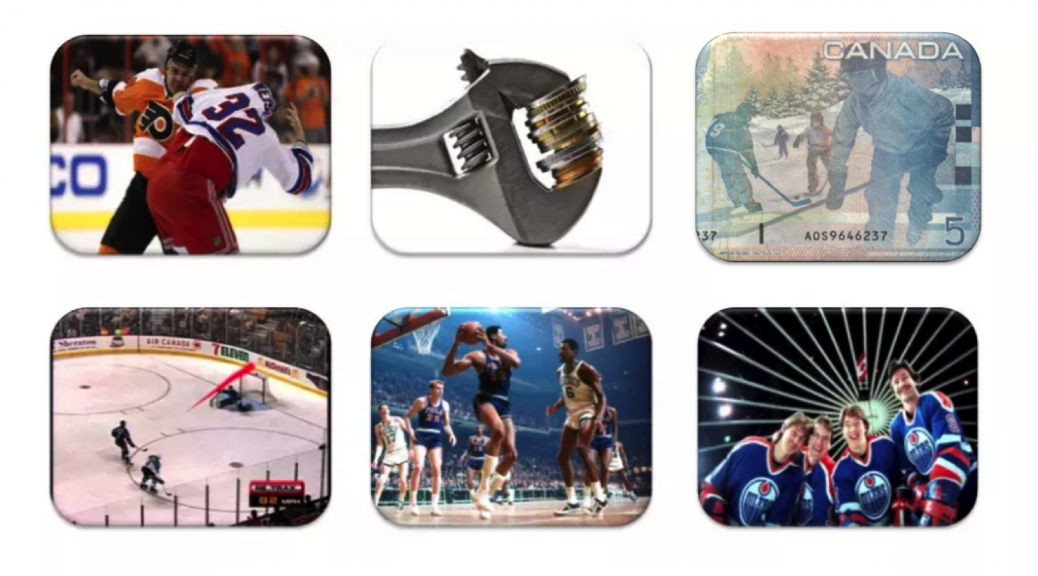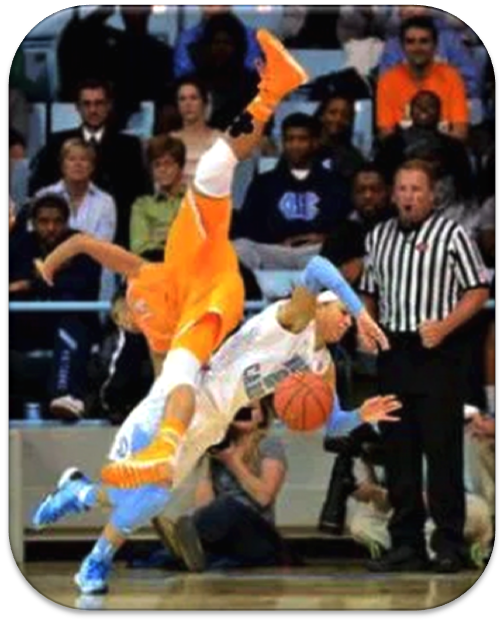The default on something you really love is to not make any changes to it. But this was a light-hearted, satirical article that I thought was a funny counter-argument to the status quo view about how pro-hockey should evolve. I love hockey, from street and drive-way games to ice rinks in the backyard (-20 Celsius), it’s part of who I am, nothing wrong with thinking differently in my opinion. As I suspected when I posted these ideas, a lot of people were actually offended by the thought of any such changes. So chill, take these Swiftian recommendations with a grain of salt. Swiftian in the sense that they are pretty severe changes that aren’t going to be embraced and I am intellectually free to disavow any of the below ideas at any future day…. so, yeah….It was just a thought experiment, lol!
Fighting, Body Checking & Pucks
Ice hockey is the national sport of Canada and it’s very popular in other northerly countries. But, it could be more popular than it currently is. There could be better talent in the sport today but the problem with hockey is the current manner in which the sport is played, the way the rules re-enforce certain behaviours and of course, the sport’s requirement of a lot equipment which isn’t help to low-income kids….
There are several factors that could explain why hockey is less popular than basketball, baseball, football, soccer (football). And these factors could be fixed without completely changing the sport. I think change in certain areas could improve the sport’s global popularity and therefore increase the calibre of players, the level of entertainment and the awesomeness of this the greatest of sports. That’s right, I’m greedy, make the best better…..You might not like these ideas so convince me otherwise on an argumentative basis if possible.
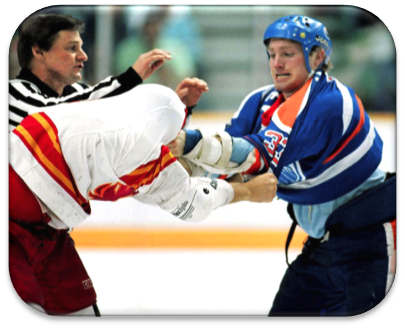 Punch Me, Grab Me, I Can Assault You….On Ice
Punch Me, Grab Me, I Can Assault You….On Ice
One of the hinderances to hockey’s success as a global sport is fighting. Fighting should not be “part of the game.” Um, just to clarify, hockey is not a game, it’s a sport. Everyone gets excited in the stands (supposedly) when they see a fight on the ice. And yet, this regular season game is supposed to be a family outing and sponsored by Tim Hortons, you say??? If there are young kids watching, it’s probably not the best example to set for those kids when two professional/paid hockey players are punching each other in the face, or wildly groping around in order to maximise bodily harm. It is illegal to assault a fellow human being….in you know…the real world under the Canadian Criminal Code. Of course, kids know that this is currently part of the game and kids aren’t taking the fight to the streets, but we can’t expect publicly condoned violence to NOT have some effect on people in other contexts.
So, the issue here is: fighting is entertaining but it’s kind of an embarrassing part of hockey. If you ask a Western European; a person from the United Kingdom, for example, what they think about when they think ice hockey, they naturally focus on fighting. I guess potential fans tend to remember random acts of violence rather than other things like talent & skill.
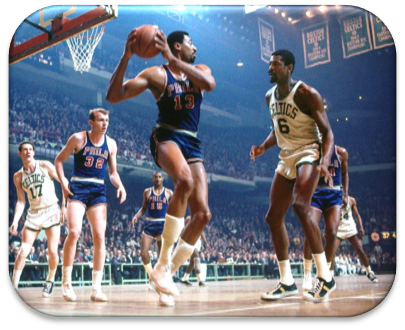 The NBA of Hockey
The NBA of Hockey
The NBA, the National Basketball Association, used to have fighting in the 1960s when the sport was still in its nascent phases of commercialization….another sport invented by a Canadian (Dr. Naismith)….randomly enough….
Anyway, fighting was phased out as the demographics of the sport changed and the sport matured… Low and behold, Basketball got much much more entertaining. Rucker Park experimentation arrived on the basketball court…fresh players started a new fad called dunking. The Lakers moved to LA, where there are no lakes and so on. Today, the average NBA franchise is worth 1.1 Billion USD. Just looking at the performance of the NHL here and I’m disappointed with year on year growth, folks; only the Toronto Maple Leafs, Montreal Canadiens and the New York Rangers are worth more than 1 Billion USD in 2016.
Now of course, you can point out that there isn’t much equipment needed to play basketball so the sport is able to grow faster BUT it is strange that fighting was ruled out in the 1960s and now basketball is a global sport….Meanwhile hockey still hasn’t changed from being a predominately caucasian and middle-class sport. Nothing wrong with that necessarily, it’s just that punching people in the face, isn’t as attractive to new entrants as you might think.
When you look at the demographics of Canada, you would think that there would be more non-white players in hockey but there aren’t. There is a pattern with sports that want to go mainstream…they inspire people across demographics to play the sport. Random violence isn’t the only barrier to better & more talent in hockey but I don’t think it helps.
 Deterrence Through The Use Of Lawful Force
Deterrence Through The Use Of Lawful Force
Now, fighting is the most obvious, surface level issue about hockey. But, underlying fighting is a deeper problem. Fighting is partly a means of deterring opponents from engaging in the body checking OF HIGH VALUE players. If you can bodycheck or slash Wayne Gretzky and knock him out of game seven of the Stanley Cup final then you should go do that because the sport permits exacting bodily harm on fellow athletes. It’s a full contact sport.
So, what ends up occurring in this rational choice scenario is that players actively use body checking to harm others and thereby gain strategic deterrence in game situations. But, in effect, what this does is it slows down the flow of the game. There could be more flow in this sport, it could be less about masculinity and blunt force, and more about skill and playmaking BUT body checking is the barrier to creating a sport that is more appropriately led by skilled players. Don’t tell me that bodychecking is a skill, I know it’s a skill, but it’s not a skill that adds to the health and well being of fellow players, bodychecking prevents athletes from reaching their full potential. Eric Lindros is just one of the NHL greats whose career, I recall, was cut short.
Here’s a list of talented players whose careers were cut short by injuries:
- Pat LaFointaine (concussion)
- Bobby Orr (knee)
- Marian Gaborik (knee)
- Peter Forsberg (ankle)
- Steve Moore (concussion)
- Adam Deadmarsh (concussion)
- Matthew Barnaby (concussion)
- Keith Primeau (concussion)
- Dean Chynoweth (concussion)
- Dave Scratchard (concussion)
- Cam Neely (knee)
- Dennis Vaske (concussion)
- Scott Stevens (concussion)
- Steve Yzerman (knee)
- George Courtnall (concussion)
- Stu Grimson (concussion)
- Pavel Bure (knee)
- Mike Richter (concusion)
- Mario Lemieux (hip/back)
- As mentioned, Eric Lindros (concussion)
- Insert name of countless friends from your local community who had their NHL dream cut short by an injury.
 Marty McSorley-Missed
Marty McSorley-Missed
Actually if you look at it, Wayne Gretzky and the Edmonton Oilers had a set of players who acted as body guards for Wayne Gretzky. These guys would body check opponents and escalate that conflict to 1 on 1 fights in order to establish that Wayne Gretzky wasn’t to be touched on the ice. They were sort of body guards, bullies if you will, and they would use their physical strength to assert themselves and protect Gretzky. In the process, they also had altercations that became fights, true, and they would fight on the ice and punch their opponent’s faces with blood soaked glee. Like mixed martial artists or boxers. But the point of the fight was that it was morale boosting.
More than anything a fight is about saying “Hey, check yourself. You have violated our unspoken law about egregiously harming myself or top players, and I want to equalize that by fighting you.” I guess, the problem is that these types of players are occupying ice time which would be better suited for creative & skill players. Don’t be fooled by the logic that defencemen will not be able to contain the offence because bodychecking is retricted. The game will be more skill based if you have to intercept the puck rather than a player’s body….at least it’s worth considering.
So fighting and body checking are not separable; you can’t remove one without removing the other. At least not without a lot of difficulty.
 Equipment As A Barrier To Potential Talent:
Equipment As A Barrier To Potential Talent:
The equipment problem is the biggest of all problems with hockey. Purists hate changes to their sport but if I was an equipment manufacturing executive I would be for all kinds of changes to hockey. And it turns out, manufacturers have made a killing on contact sports. Circa 1959, Plante gets hit in the face one too many times, good, equipment manufacturers have a new category. Someone gets cut in the neck, sell a neck guard for $25 bucks. Elbow pads aren’t big enough, charge double. Manufacturers are saying today “let’s keep hockey a semi-violence sport so that we can increase our revenue, shall we?”
And looking into the distant past, it’s not like Guy LaFleur was laying out opponents every game…..
Ever notice how equipment manufacturing for hockey has ratched up the gear? Most notably in the past 25 years….First there was the mandatory helmets then there was more padding generally. As the sport developed alongside American and Canadian football, these sports informed manufacturers about how best to protect players from eachother. You could split your expensive research & development costs across a bunch of contact sports…With more padding came an increase in physical altercations as part of the game.
Today, the pads take the brunt of the discomfort in laying the hit. It’s hard to ignore the fact that hockey requires so much expensive equipment, meanwhile, purists believe that body checking is integral to how the sport is played. Seems like a perfect accident that these two interest groups have shaped the sport.
Now, it’s not likely that equipment manufacturers have intentionally made it easier to comfortably body check opponents and in so doing made the game less approachable for the working class by making the sport so expensive….in all likelihood, equipment manufacturers were responding to player demand. So I can’t fault the equipment manufacturers for making a living here. However, I kind of doubt that manufacturers would want to restrict body checking as it would mean less profits for themselves….at least in the short-term. Long term, I would expect more sticks to be sold globally.
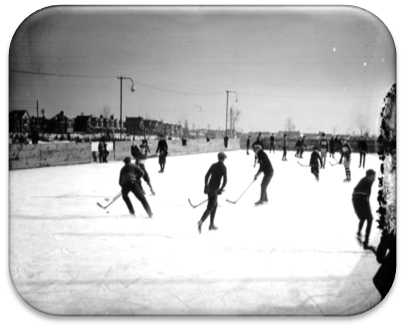 Lost Legends That Never Were And I Have No Proof Existed….
Lost Legends That Never Were And I Have No Proof Existed….
So, I’m still talking about fighting, but in truth body checking is the core of the problem with ice hockey. It wasn’t always about body checking because there weren’t pads when you played shinny as a kid. Think of how many players in their youth stopped playing ice hockey around age eight or nine. There are statistics that show that this occurs, that there’s a significant drop off of player talent in the mid-teens as well.
If you read Malcolm Gladwell’s book “The Tipping Point,” you’ll know that obviously people who are born earlier in the year have a few advantages in life. If you were born in January of a given year, you can still play ice hockey against people (11 months younger than you) who were born in December but are still considered a nine year old. And the growth spurts of those two individuals could be wildly different, the guy or girl born in January could be several inches taller and larger than the guy born in December of the same calendar year, on average.
So, you have created an inequality in the development of the players that is exacerbated by the serendipity of bodychecking at random. Also, more importantly, by the age of nine, you introduce body checking as if it has to be part of the sport. If you’re body checking someone at an early age, they’re still growing, you’re putting their bodies under duress. It’s quite similar to American or Canadian football. These kids get bruises, it’s a brutal sport, it’s a lot of fun to pummel each other with really expensive, heavy equipment but in hockey?….the long-term problem is that it could be harming the development of great skill players. Ultimately, the problem is that body checking may lead many kids to actually just quit and never play the sport again…
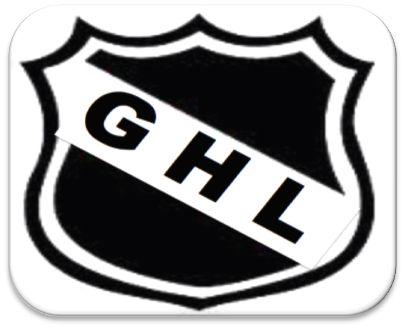 Possible Solution: Create Parallel/Competing League…
Possible Solution: Create Parallel/Competing League…
So I know these ideas are ridiculous but I think that these changes would benefit the sport but lets A/B test it first. A/B testing is where you have two versions of a thing you are testing & then you include a new factor into one of the two in order to decide which one is better. There will be a lot of people who will decry any change to the sport because the sport is “great the way it is” just like the horse and carriage is the best way to get around circa 1875, but what these folks don’t realize is the key concept that this post is about; which is the hidden costs of the way the game is played today. When the automobile was popularised, there was a transition period. The sport could be better than it is presently but I can’t prove that at present because there is no other league to compare with the NHL.
Of course there was the WHA in the 1970s, teams like the Edmonton Oilers were infact from that league. I’ll put good money on the idea that a new Global Hockey League which would be a 21st century hockey league that, if it restricted body checking/fighting, would dwarf the NHL within 10 years pulling the carpet under the “best” in traditional hockey. Get ready for Moscow vs Montreal, October 15th, 2035. Yes, if you can’t join ’em replace ’em…..Let the free market decide which league is better. Just a thought though.
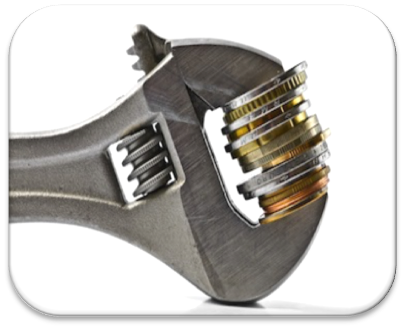 Hidden Costs Are Expensive
Hidden Costs Are Expensive
As we’ve seen the hidden costs of body checking and fighting are wide ranging. The equipment issue is probably a bigger problem than anyother but we don’t realise these costs for sure because there’s no alternative reality or parallel league to see these changes in play. There must be 1000s of talented athletes who left the sport because of injuries. Players competing in Bantam hockey across Canada and elsewhere no doubt hit a threshold of pain that could not be overcome because the sport was wedded to random acts of violence leading to unexpected concussions….all in the name of this being part of the game. Again, hockey is a sport, not game. Checkers is a game.
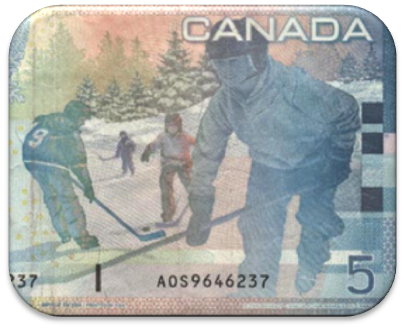 Talent = Skill = Entertainment = Intellect = Revenue
Talent = Skill = Entertainment = Intellect = Revenue
You can completely disagree with me but if the sport can be more lucrative, popular and globally respected through these changes then what’s your problem? As I mentioned above, the average NBA team is worth more than the average NHL team by quite a lot. Hockey is a skill sport, a sport of intellect, of strategy, a sport of physical fitness, a sport that requires agility, endurance. There is intellect in body-checking but there is more intellect in playmaking, I suspect. If you look at any NHL game highlights, body-cheking is rarely emphasised. It’s a fantastic sport that has a huge, huge hidden cost inserted into it by the contact component; the body checking within the sport is really expensive from an equipment, injury & skill standpoint.
Canada has the highest post-secondary education rates on earth. Our heroes should reflect the demographics of Canada not just the best bullies in the playground. I am in no way saying top hockey players aren’t intelligent, don’t miscontrue the argument, it’s just that it’s possible that bully-centred players are potentially crowding out talent from market. There is no way to know for sure because there is no parallel league to compare the NHL to but I’m saying some smarter players never get the chance to play because of the way the sport is currently played. It’s quite possible that hockey fans globally want to restrict body checking but don’t have any means to express their decent. I believe they would spend more money watching hockey if body checking was restricted and I can explain why. But first, we should ask what Mohammed Ali thinks about body checking…..Oh right, he’s sustained too many hits to the head to speak competently about a sport he never played. Maybe body checking should be restricted to improve the lives of current & future-retiring atheletes? Also, hockey is not MMA or boxing. Hockey is better than these sports in my opinion. There is a place for violence in sport. I’m saying that violence shouldn’t play such a significant role in hockey.
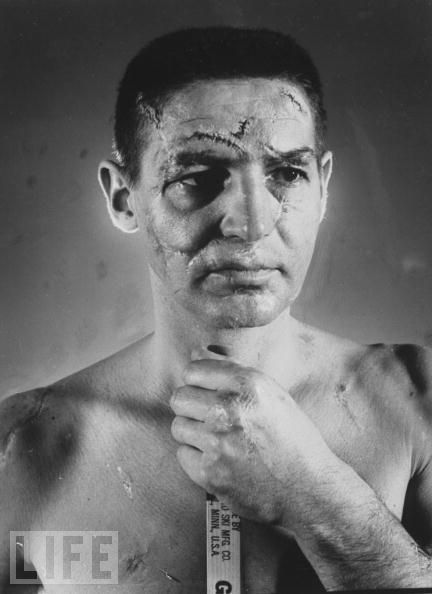 One Group Guaranteed To Disagree With Me
One Group Guaranteed To Disagree With Me
Now before I upset purists further, let’s agree that those who most forcefully oppose penalising body checking are likely to be the NHL players who have the following problems:
- They’re bulky and physically threatening on the ice;
- They don’t have the head for strategy play;
- They dream about the cheers they get when they lay a huge hit;
- They can’t skate worth a damn but can slash you like a champ;
- Their shot accuracy, speed, agility & general talent are below average.
- If these changes mentioned in this article actually happened, they would lose their jobs as more talented players crowd them out of the league.
So yeah, the people who most forcefully oppose changes are those who benefit from the status quo. My point is not that if you disagree with me you are a ‘dumb goon’ or something, it’s that the sport could quite possibly be better IF the sub-sect of enforcer players were phased out THEN everyone else would benefit. That includes fans, teams, GMs and the overall global potential of the sport.
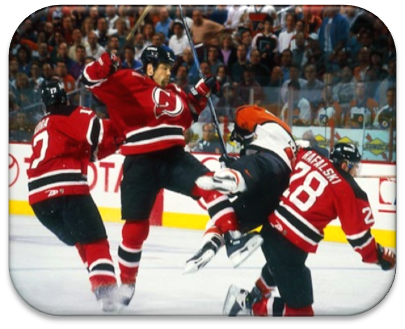 Serendipity of Body Checking
Serendipity of Body Checking
As mentioned above, Canadian football, American football, for the most part have very coordinated and fairly standardised contact. You have contact where two players pummel each other, directing their physical force in a single direction and the sport is built around anticipating hits. In ice hockey, it’s random, it’s serendipitous, i.e. someone crossed the blue line with their head down and gets a concussion, someone plows into the corner boards headfirst and is a paraplegic for the rest of his life.
The hits are not coordinated in anyway and can occur at any time on the ice. It’s random like a car accident or a cancer diagnosis…Obviously, hockey needs to at least restrict body checking. Once you get rid of body checking, as a non-starter fighting is out, it doesn’t make logical sense anymore to have the fighting deterrent, and you improve the total pool of potential players in the sport. Of course, making the penalties for bodychecking harsh and suspending fights would change the game quite a lot.
Just because you make something less appealing doesn’t mean it will stop immediately at first. But I’m sorry, hockey already has enough going against it as a global sport, most notably the fact that it is played on frozen water. But at least, the full pool of individuals who could be playing hockey could grow substantially if you change the sport to remove body checking and fighting from it.
Nail in the coffin
Now, that you’ve read this far along, I need to prepare you for the final blow. Body checking does more harm than good for hockey. Body checking inflates the cost of participating in the sport. Removing it would make hockey more accessible. To prove my point further, I’ve mentioned the NBA several times before. Well, I have just one last thought for you. Can you imagine basketball with bodychecking? Would the sport be better? As a hockey fan, are you strangely drawn to the prospect of basketball with body checking? Interesting, right?
 Commercial Viability of The Spectacle That Is Hockey
Commercial Viability of The Spectacle That Is Hockey
Now, here’s where purists take a nose dive & get extremely upset with my argument, it’s not connected to the body-checking fighting paradigm, but is the number one complaint I hear in the UK. I’m happy to separate the following idea from the other two above but if you look at it from a commercial perspective and I’m putting my commercial hat on here, there was a time in the 90’s when the US broadcasters highlighted the puck on the ice, specifically to help fans see the puck. Of course, that was annoying and it was kind of a problem to viewers in Canada. Just a bit of a problem. Many Canadian fans felt that the TRAX PUCK was an affront to the sport, but net revenue and growth of the sport increased in that period. The truth is FOX subsequently dropped this strange highlighted puck solution and because of audience confusion (among other factors) FOX cancelled their coverage; the numbers didn’t add up. But, that failure has a self-fulfilling element to it.
The problem is still that new fans can’t see the puck in some instances. I think the third thing that they should change, and I say “they” I mean commissioner Gary Bettman of the NHL; he should get rid of the black hockey puck and replace it with a neon coloured hockey puck that’s easy to see. Because there is no doubt with even with HD television, you will have situations where it looks like everyone is skating around with no puck. Why am I watching mimes right now? Where’s the puck? They’re throwing around a puck at high speed and you can’t see it. Literally, how the players react is our best guess at where the puck is. It can be quite annoying for those who did not grow up with the sport. Now, I did grow up with hockey but I empathize with non-hockey fans who could love the sport. In fact, those who grew up with hockey have a vivid imagination as to where the puck is and thus like it the way it is. I think if you made the puck in NHL games neon or green or orange it would have a positive impact. Apparently having an orange puck was common practice in the WHA. Just saying. I know this sounds like an awful idea to have a puck you can see more easily but try it before you fry it. I think it’s worth exploring changes to the sport to penalize body checking, outlaw fighting and change the hockey puck to orange so there you have it. If you’re still not sold on these changes then consider the following……
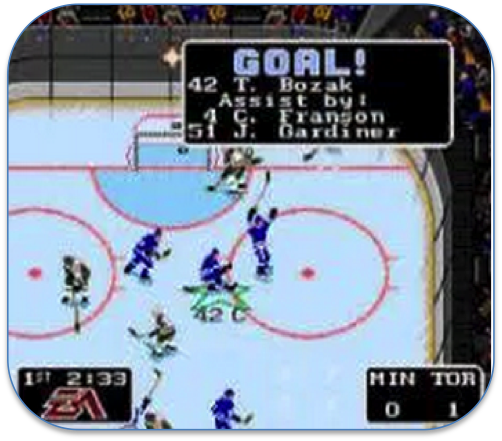 Increased Diversity & Increased Skill & Increased Spectacle
Increased Diversity & Increased Skill & Increased Spectacle
An ancillary consequence of these changes could be problematic in and of itself and that would be, potentially, that there would be more hockey players competing for a handful of actual NHL jobs as NHL players, and the quality of hockey would increase and skilled players would dominate the sport. Now why that would be a bad thing I’m not quite sure just yet, but I’m pretty sure that would be the consequence. There would be increased competition because there would be a greater pool of athletes to choose from. There might be even, dare I say it, women hockey players. Now that’s just crazy….So, diversity is another beneficiary of this change in policy. Anyway, those are my thoughts. If you like one of the three ideas that’s cool, if you hate them all let me know. Convince me otherwise on an argumentative basis if possible.

